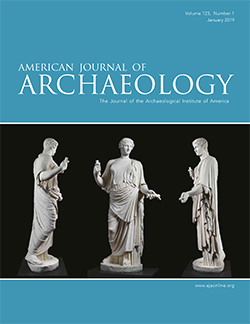AJA Open Access
BY-NCJanuary 2019 (123.1)
Book Review
Cage Cups: Late Roman Luxury Glasses
By David Whitehouse, with William Gudenrath and Paul Roberts
Reviewed by Janet Duncan Jones
Cage Cups is the long-awaited comprehensive study of an extraordinary category of late Roman luxury glass undertaken by Whitehouse, former executive director of the Corning Museum of Glass. Whitehouse had a career-long fascination with the cage cup, a vessel with delicate openwork decoration that combines beauty, technical virtuosity, and functionality. Used primarily as lamps (some cage cups were found with their hangers still attached) or drinking vessels (some have inscribed toasts forming part of their decoration), they have been found throughout the Roman empire, but concentrations of find spots in Germany, Italy, and in the eastern Mediterranean make those areas the likeliest locations for workshops. A few examples date from as early as the late first century C.E., but most are of late third and fourth century C.E. date.
This volume, handsomely produced and amply illustrated in color, gathers all examples of cage cups known to the author and presents a clear account of their history and of the important, sometimes contentious, debates involved in their study. It serves both as an important resource for the specialist, who will benefit from Whitehouse’s meticulous scholarship and comprehensive bibliography, and as an accessible, visually appealing, and engaging introduction for a popular audience.
Chapter 1 presents a helpful overview of the topic, combining both archaeological and literary evidence and capturing the extraordinary nature of the cage cup and its interest as a subject of study. Chapter 2 presents the rare early examples, two vessels from Nijmegen (Netherlands) and Tongeren (Belgium) dated to the late first or second century, and two vessels of less certain date from the Begram hoard, including the famous Lighthouse Beaker (does it represent the Pharos of Alexandria?). These vessels open a fascinating window onto the evolution of a technique that combines the efforts of artisans skilled in the separate crafts of hot and cold working. A bonus of Chapter 2 is Whitehouse’s detailed account of the current debate over the dating of the Begram hoard. Chapter 3 is an entertaining history of the discovery of cage cups and of the scholarship through the ages about them. Chapter 4, on the characteristics of the cage cup, gathers important details about all known shapes (dishes, bowls, beakers, bottles, amphoras, and buckets), inscriptions, colors and arrangements of colors, and dichroism. Chapter 5 details distribution and dating.
For more than 200 years, debate has revolved around the method of manufacture of these fragile vessels, becoming particularly contentious in the last several decades. In Chapter 6, on the manufacture of cage cups, Whitehouse carefully presents the different theories and the evidence for each. The most traditional view, supported by close examination of fragments in recent decades, has been that the cage was cut from a previously blown blank by a glassworker specializing in cold working. The cutting process left an inner cup attached to an outer cage by thin struts remaining from the coldworking process. In the 1990s, Rosemary Lierke presented evidence for her view that the vessels were formed by pressing molten glass into molds, with the struts forming from glass pressed through a perforated inner mold (“One More Time: The Making of the Diatreta Cups,” Glass Science and Technology 68 [1995] 195–204). The vessel was then finished by cold working. Her argument focuses on the lack of traces of cold working on the outer surface of the cup itself. A tense, illuminating, and at times entertaining debate has been ongoing at conferences and in print. Whitehouse remained unconvinced by Lierke’s proposal and responded to it in detail in this chapter. Lierke, in turn, has responded at length in her review of Cage Cups (in Pressglas-Korrespondenz 2016). Technology was not the only argument between Whitehouse and Lierke. Lierke ([1995] 197) has also objected to the idea of the use of cage cups as drinking vessels given their weight and fragility, while Whitehouse dryly concludes that he finds it “much less daring to conclude that beakers inscribed with toasts were intended for use by participants in a drinking party, especially if the toasts were addressed to real people” (16).
I had firsthand experience of Whitehouse’s love of the cage cup, when, as a young scholar, I brought several scrappy glass fragments from the excavations at Aqaba (ancient Aila) to the Corning Museum for Whitehouse’s opinion. I had a hunch that one of them might be from the rim of a cage cup, but I wanted his confirmation and, to be honest, to see his reaction. The fragment was near the middle of the stack and it was well worth the wait to see his British reserve slip when he first saw it and confirmed that we had a new cage cup to add to the corpus (no. 50 in this catalogue).
The completion of a work on a subject of career-long interest is cause for celebration. When that publication is posthumous, the occasion is bittersweet. At the time that he died in 2013, Whitehouse, then senior scholar at the Corning Museum of Glass, was working to complete this volume. In the end, it takes a village, and Whitehouse's colleagues—most notably William Gudenrath, resident advisor at The Studio of the Corning Museum of Glass; Paul Roberts, senior curator and head of Roman Collections at the British Museum; and St. John Simpson, archaeologist and senior advisor at the British Museum—stepped in to see the volume to publication. It is, then, both a welcome study of a significant aspect of Roman material culture and a fitting tribute to its author and to the importance of his contributions to the field.
Janet Duncan Jones
Department of Classics and Ancient Mediterranean Studies
Bucknell University
jjones@bucknell.edu
